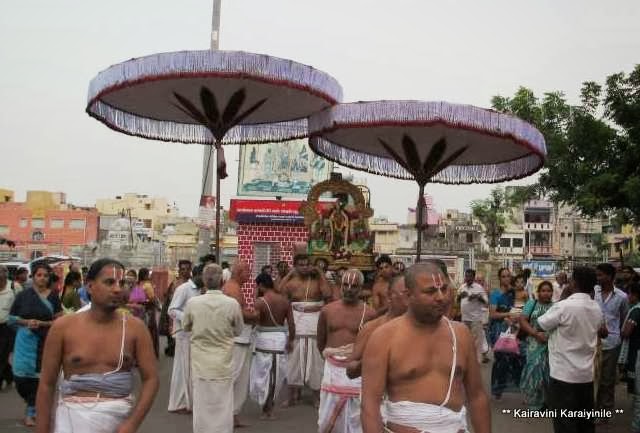I have recently posted about ‘Garuda
Sevai purappadu’ and our visit to the serene ThiruNarayanapuram kshetram. We had the fortune of the benevolence of Lord
Selva Naranan whence we there for another purpose.
The name 'Pandavapura' means "Town of Pandavas". Legend
has it that the Pandavas during their period of exile stayed here for sometime,
and Kunti, mother of the Pandavas, liked the hillock so much that it became one
of her favorite haunts. The town has historic relevance also as it was used as
the camping ground by the French army, which came to help Tippu Sultan in his
war against the British. It is believed that French named the small town as
"French Rocks", as the town is in the vicinity of two rocky hills.
Pandavapura having paddy and sugarcane fields is 130 km from Bangalore
and 25 km from Mysore.
There are many jaggery manufacturing units too adding sweetness to the town
which has Cauvery water flowing through Visweswarayya Canal.
To us, devout Sri Vaishnavaites, this place – to be specific a small
village known as Siruputhur ‘Kiranganoor’
[Hale Kiranguru] in Srirangapatna taluk is of significance as it is associated
with one of our Acharyars. I have been writing about the mahothsavam at
the Holiest Thirumala for Sri Thirumalai Ananthalwan, a great Acharyar who did floral service for Thiruvengadamudayan,
about 1000 years ago. Of the many
divyadesams sung by Azhwaargal, Thirumala occupies a very prominent
position. Our Acharyan Emperumanaar
(Udayavar, Ramanujar, Bashyakarar, Yathi Rajar, ……….) did many service to the
Lord here and Udayavar was instrumental in many of the religious practices
being established in Thirumala. One of
his disciples is ‘Thirumalai Ananthazhwaan’ who was very attached to
Ramanujar.
Sri Ananthazhwaan was born in year 1053 near
Mysore in a village called ‘siruputhoor’ ~ now called Hale Kiranguru in
Srirangapatna Taluk 571807 situate on Pandavapura Station High Road. When Udayavar was rendering kalakshepam on
Thiruvaimozhi, (the verse – sindhu poo magizhum Thiruvengadathu – meaning the
place replete with flowers), Udayavar asked whether anybody would do the pushpa
kainkaryam at Thirumala. Remember,
Tirupathi was a very dense jungle ridden with wild animals with adverse
weather. Ananthazhwaan readily came
forward and said that he would go, if Udayavar so desires. Udayavar was so elated that he praised
Ananthazhwaan as the real man and till date, his descendents have the name
‘Thirumalai Ananthanpillai’ meaning manly.
Legend has it that Ananthazhwaan was organizing ‘a
flower garden’ – he was constructing a lake for supply of water on the hills –
an extremely arduous work. Lord Balaji
in one of His Thiruvilayadals, came to the place and tried helping him. Wrongly assuming the person as hindering the
work, Ananthazhwaan threw the crowbar at the Lord (without knowing Him); later
realised his folly and got the Divine Blessings of Lord. This is the crowbar now seen at the entrance
of the Temple of Supreme Lord Thiruvengadam Uaiyaan.
Thirumalai Ananthazhwaan continued his floral and
other services to Lord Srinivasar for many years. He was so devoted in his
service ordained by Ramanujacharya that for him, it was service that was of
primary importance, even when compared to God. The Vigraham of Sri Ramanujar that we
worship inside the Sri
Vari Temple
was installed by him. ‘Sri Venkatesa Ithihasa maala’ is considered the best
amongst the many works of Thirumalai Ananthazhwaan
For the past few years, anniversary
Uthsavam of Sri Ananthazhwaan is being celebrated at his place at Thirumala. His descendants thought it fit to organize one
at his birth place too and this year on 22nd Sept 2013, his 961st
Thirunakshithira celebrations were grandly conducted at his avathara sthalam at
Kiranganoor. Understand that till a few
years ago, other than a slab nothing existed here ~ now it is a beautifully
constructed place having a water tank, a Sannadhi where Thiruvengadam Udaiyan,
Sri Ramanujar and Sri Thirumalai Ananthan pillai are worshipped.
There was the ‘Thiruvaimozhi Sarrumurai’, Ramanuja
Noorranthathi and Upadesa Rathinamalai sarrumurai by hundreds of Vaishnavaites
comprising of Adhyapakars from Kovil, Thirumalai, Perumal Kovil,
Thiruvallikkeni and other divyadesams and of course from Thiru Narayanapuram
too. The function was well organized
thanks to the untiring efforts of Sri SeluvaNaranan swami, adhyapak Melkote and
Principal of Melukote paatasaala; Sri MA Venkata Krishnan Swami, Sri Kannamani swami, Sri Ananthachar swmai,
Sri Srirangachar swami, Sri SrirangaPatnam Ananthachar Swami, and many
others. Sure I would have missed out the
names of some because those Organisers remained at the background and a visitor
like me could easily could have missed some who were the backbone. My Pranams to those Organisers.
Sri MAV Swami in his concluding speech thanked all
who had travelled to the Avathara sthalam and those from Thirunarayanapuram who
despite their old age had come with zeal.
He made the metaphor of Arunodhayam preluding Suryodham – that this
event happening as a prelude to the much bigger celebrations that WE all should
be doing on the Thousandth Thirunakshithira vaibhavam of Emperumanaar. Sri PB
Rajahamsam swami underlined that at this very place Sri Ananthaazwan embraced
Sri Bhattar terming him as ‘Engal
Kudikku Arase’.
Overall, the event exhibited the great coordination
of Melkote Sri Vaishnavas and the hospitality of them and of Sri Ananthaazwaan
Trust. The garden created by
Ananthazhwaan in Thirumala Tirupathi is
now known as ‘Puraisaivari Thottam’. Twice in a year, Sri Malayappar visits this place and honours
Ananthazhwaan now in the form of Magizha maram.
MAV Swami informed us that a branch of the same Magizha tree was taken,
planted here and has grown in to sweet fragrance pervading tree here too.
Let us worship the feets of Thirumalai
Ananthazhwaan who was renowned for his knowledge, devotion, steadfastness and
more good qualities. Some photos taken during the celebrations are here.
Adiyen Srinivasa dhasan.
















































